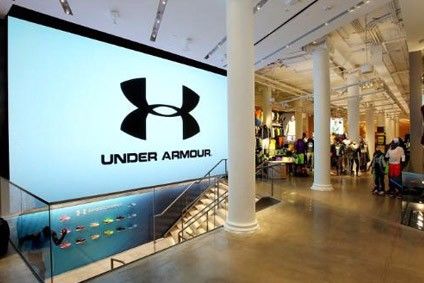- For the three months to 31 December, revenue fell 2.6% to $1.40bn. Wholesale revenue dropped 12% to $662m and direct-to-consumer revenue increased 11% to $655m, driven by 25% growth in e-commerce.
- North America revenue in the fourth quarter fell 6% to $924m and international revenue increased 7% to $448m – with an 11% drop in EMEA, a jump of 26% in Asia-Pacific, and a rise of 2% in Latin America.
- Q4 apparel revenue was down 4% to $931m, footwear declined 7% to $241m, and accessories jumped 32% to $145m.
- Q4 net income was $184m, compared with a loss of $15.3m a year earlier. Excluding the gain on the sale of the company’s MyFitnessPal platform, adjusted net income was $55m.
- For the full year, revenue was down 15% to $4.5bn with wholesale slipping 25% to $2.4bn and direct-to-consumer up 2% to $1.8bn, driven by 40% growth in e-commerce.
- FY North America revenue dropped 19% to $2.9bn and international revenue fell 4% to $1.4bn.
- Net loss for the year was $549m versus a profit of $92,1m a year earlier. Adjusted net loss was $120m.
Despite many markets experiencing a second wave of the pandemic towards the end of 2020, Under Armour only suffered a 2.6% decline in sales in Q4, leading to a respectable full year sales decrease of $0.8bn to $4.5bn.
An increased focus on its direct-to-consumer channels somewhat offset the decline in wholesale revenues, with DTC sales increasing by 2% for the year, driven by online which accounted for 47% of this revenue and saw growth of 40%. Under Armour’s sportswear specialism has also protected sales throughout Covid-19, but its emphasis on performance styles means that it hasn’t benefitted as much as rivals NIKE and adidas from sales of more casual lifestyle items such as joggers and hoodies, which became staple items in consumers’ wardrobes as they spent more time at home.
A significant factor driving Under Armour’s FY2020 revenue decline was its heavy reliance on the US, where sales fell 19.5% due to the prolonged impacts of Covid-19 on consumer confidence and discretionary spending. This proves the importance of the brand’s focus on other regions, with it recently opening a new warehouse in the UK to help protect it from costs associated with Brexit.
Unsurprisingly, due to the region’s more astute handling of the pandemic, Under Armour’s best performing market was APAC, which only experienced a minimal 1.2% decline in sales in FY2020, driven by robust performance in Q4, when sales grew 26.1%. However, this region only accounted for 14.0% of total revenue, so the brand should focus on growing its APAC presence further, particularly in China, through country-specific product drops (competitor Adidas has released a Lunar New Year collection) and targeted digital strategies.
Accessories was Under Armour’s star performer in FY2020, registering only a 0.5% drop in sales due to the popularity of its Sportsmask that is designed specifically for exercise. Revenue in its Connected Fitness segment also only decreased by 0.4%, with its MapMyRun app resonating with consumers as they prioritised their health and wellbeing, and the app having the additional benefit of boosting brand loyalty.
Under Armour should also continue to invest in, and raise awareness of, its Connected Footwear as consumers become more interested in the statistics involved in running to help set it apart from competitors. As professional sports resume, gyms reopen, and consumers continue to invest in their health and fitness, Under Armour is on track to deliver a more robust performance in 2021

US Tariffs are shifting - will you react or anticipate?
Don’t let policy changes catch you off guard. Stay proactive with real-time data and expert analysis.
By GlobalData



